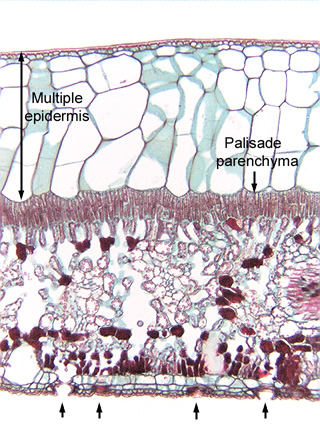Up
Ordinary epidermis
Guard cells
Thick cuticle
Thicker cuticle
Thin cuticle
Parasitic plant
Petal epidermis
Sclerified epidermis
Papillose epidermis
Sculptured cuticle
Elaborate cuticle
Cuticular horns
Radial walls
Cuticle proper
No epidermis
Epidermal peels
Cycad peel
Paradermal
Typical stoma
Sunken stoma
Stomatal orientation 1
Unusual orientation 2
Artifact
Stomata and fibers
Stomatal crypts
Crypts, mag.
Crypt margin
Non-crypt
Water lily
Stomatal channels
Groove, hi mag
Subsidiary cells
Ledges
Papillae
Trichome
Uniseriate hair
Peltate hair, mag
Peltate, lo mag
Branched hairs
Trichome base
Lithocyst, Ficus
Lithocysts, hemp
Bulliform cells
Grass epidermis
Multiple epi
Uniseriate?
Peperomia
| |
 Fig.
10.6-1. Transverse section of fig leaf (Ficus). The thick band
of giant, empty-looking cells is part of a multiple
epidermis. There is a layer of cells that appears to be an epidermis,
but those cells are only part of the total epidermis; both they and the giant
cells are derived from the protoderm. In a uniseriate epidermis, protoderm cells
divide with anticlinal walls only, but in a multiseriate epidermis, protoderm
cells divide in various planes. In species like this in which the outermost
layer looks so much like an epidermis – and the inner layers of giant cells
look so unlike epidermis – developmental studies are necessary to be certain
that it is a multiple epidermis and not just a uniseriate epidermis and an
unusual hypodermis. Fig.
10.6-1. Transverse section of fig leaf (Ficus). The thick band
of giant, empty-looking cells is part of a multiple
epidermis. There is a layer of cells that appears to be an epidermis,
but those cells are only part of the total epidermis; both they and the giant
cells are derived from the protoderm. In a uniseriate epidermis, protoderm cells
divide with anticlinal walls only, but in a multiseriate epidermis, protoderm
cells divide in various planes. In species like this in which the outermost
layer looks so much like an epidermis – and the inner layers of giant cells
look so unlike epidermis – developmental studies are necessary to be certain
that it is a multiple epidermis and not just a uniseriate epidermis and an
unusual hypodermis.
Several stomata are visible in the lower epidermis (arrows; the middle
two stomata are somewhat indistinct); none is present in the upper, multiseriate
epidermis.
|
 Fig.
10.6-1. Transverse section of fig leaf (Ficus). The thick band
of giant, empty-looking cells is part of a multiple
epidermis. There is a layer of cells that appears to be an epidermis,
but those cells are only part of the total epidermis; both they and the giant
cells are derived from the protoderm. In a uniseriate epidermis, protoderm cells
divide with anticlinal walls only, but in a multiseriate epidermis, protoderm
cells divide in various planes. In species like this in which the outermost
layer looks so much like an epidermis – and the inner layers of giant cells
look so unlike epidermis – developmental studies are necessary to be certain
that it is a multiple epidermis and not just a uniseriate epidermis and an
unusual hypodermis.
Fig.
10.6-1. Transverse section of fig leaf (Ficus). The thick band
of giant, empty-looking cells is part of a multiple
epidermis. There is a layer of cells that appears to be an epidermis,
but those cells are only part of the total epidermis; both they and the giant
cells are derived from the protoderm. In a uniseriate epidermis, protoderm cells
divide with anticlinal walls only, but in a multiseriate epidermis, protoderm
cells divide in various planes. In species like this in which the outermost
layer looks so much like an epidermis – and the inner layers of giant cells
look so unlike epidermis – developmental studies are necessary to be certain
that it is a multiple epidermis and not just a uniseriate epidermis and an
unusual hypodermis.